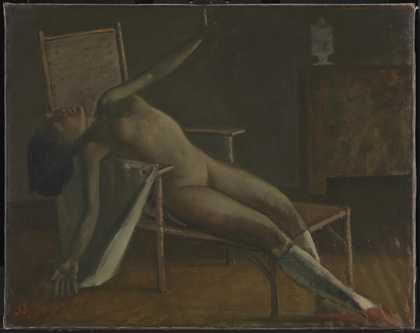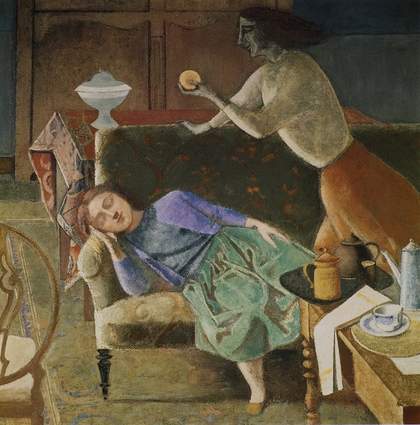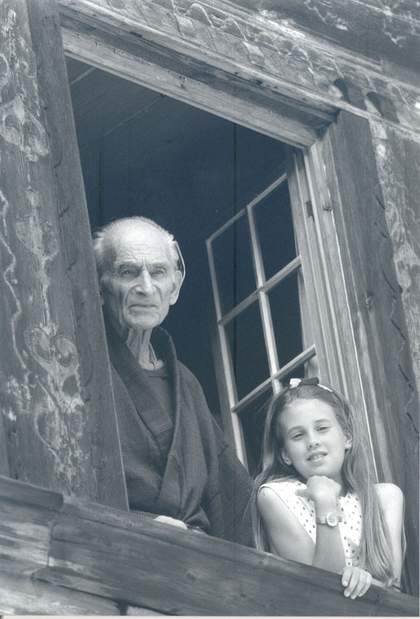Still Life with a Figure 1942 was among the first works Balthus painted at Champrovent, the seventeenth-century manor house in Savoy where he lived during the Second World War. The artist had been mobilised in September 1939, seen battle, then suffered a nervous breakdown. After recuperating in Paris during the winter of 1939–40, in June 1940 he and his wife Antoinette had sought refuge in Champrovent, which, south of Chambéry, was at that time still in the free zone not yet occupied by the Germans.
Balthus knew Champrovent from his holidays there during the 1930s with his friends the writer Pierre Leyris and his wife Betty. The Cozlin and Buisson families lived in the house, and Balthus rented the part that belonged to the Buissons while they were away. He and Antoinette did not lack company during their stay, which lasted until late 1941. His mother Baladine and his brother Pierre Klossowski came for extended stays. When the Germans moved south, Pierre hid with the Benedictine monks at the Abbaye d’Hautecombe on the Lake of Bourget. The American expatriate and writer Gertrude Stein lived with her companion Alice B. Toklas nearby in Bilignin (department of Ain). In her letters, Stein mentions Balthus visiting on his bicycle.
Balthus always used his surroundings as the settings for his interior scenes and they had a direct influence on his style. His gloomy studio at the Cour de Rohan in Paris had served as the forbiddingly severe backdrop for the painting The Children 1937 and his series of portraits of Thérèse Blanchard from 1936 to 1939. These works are starkly different from those he painted in Champrovent, with the farm’s colourful petit bourgeois parlour, as depicted in The Salon I 1941–3 and The Salon II 194), giving the pictures an atmosphere of Biedermeier comfort.

Balthus (Balthasar Klossowski de Rola)
Nude on a Chaise Longue (1950)
Tate
Still Life with a Figure is not set in the parlour, but probably in one of the wood-panelled rooms upstairs that Balthus and Antoinette occupied at the time. Georgette Cozlin (born 1928), the farmer’s twelve-year-old daughter, faces the frugal repast of home-baked bread, local cider and the last apples of the season. Echoes of the Old Masters abound, evident here in the deep claret of the table covering and the brocade curtain – a prop the artist must have brought along from Paris – and in the finely painted apples and Victorian silver fruit bowl, which form a still life reminiscent of Caravaggio’s Basket of Fruit c.1599.

Balthus (Baltusz Klossowski de Rola)
The Golden Fruit 1956
Oil on wood
© DACS 2007
Even more resonant of the past, however, is Georgette’s gesture. In Christian iconography a drawn curtain signifies the revelation of a sacred space. But while the bread, cider and silver bowl are laid out on the lace-trimmed tablecloth as upon an altar, any evocation of the Eucharist has been deftly undercut by the knife thrust into the loaf of bread. Even with the still life taking centre stage and pushing Georgette’s figure to the margin, her grim presence dominates the image. Her stern mien seems a perfect match for the frugal meal. But then moodiness and sulkiness are hallmarks of Balthus’s adolescents. His children never smile or look content. They remain remote, withdrawn and self-absorbed. They never play. Often they are pensive and float in daydreams. Balthus never chose conventionally pretty girls to pose for him. Only young girls with grave and moody looks appealed to him.
I visited Champrovent on 26 October 1981 and was surprised to find the old-fashioned parlour depicted in Salon I and Salon II had not changed. But then farmhouse parlours tend to be used only on holidays, and since the painter’s stay nobody seemed to have sat in it or removed its furnishings. (Just a few years ago they were sold at a local auction house.) Even the silver bowl was still there. During my visit I met the 53-year-old Georgette Pravaz (née Cozlin), who was by then a stout grandmother living in the neighbouring village of Vernatel. She told me that she was the model for both figures in Salon I and Salon II, the one sleeping on the sofa and the other reading a book on the floor. She admitted that when she had to pose on the sofa, she would fall asleep, and she did not care for books. Posing for Still Life with a Figure left no such vivid memories: she barely remembered it.

